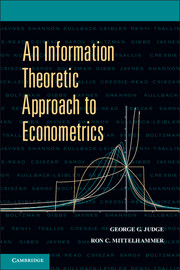Book contents
- Frontmatter
- Contents
- Preface
- One Econometric Information Recovery
- Part I Traditional Parametric and Semiparametric Econometric Models: Estimation and Inference
- Part II Formulation and Solution of Stochastic Inverse Problems
- Part III A Family of Minimum Discrepancy Estimators
- Part IV Binary–Discrete Choice Minimum Power Divergence (MPD) Measures
- Nine Family of MPD Distribution Functions for the Binary Response-Choice Model
- Ten Estimation and Inference for the Binary Response Model Based on the MPD Family of Distributions
- Part V Optimal Convex Divergence
- Abbreviations
- Index
- References
Nine - Family of MPD Distribution Functions for the Binary Response-Choice Model
from Part IV - Binary–Discrete Choice Minimum Power Divergence (MPD) Measures
Published online by Cambridge University Press: 05 June 2012
- Frontmatter
- Contents
- Preface
- One Econometric Information Recovery
- Part I Traditional Parametric and Semiparametric Econometric Models: Estimation and Inference
- Part II Formulation and Solution of Stochastic Inverse Problems
- Part III A Family of Minimum Discrepancy Estimators
- Part IV Binary–Discrete Choice Minimum Power Divergence (MPD) Measures
- Nine Family of MPD Distribution Functions for the Binary Response-Choice Model
- Ten Estimation and Inference for the Binary Response Model Based on the MPD Family of Distributions
- Part V Optimal Convex Divergence
- Abbreviations
- Index
- References
Summary
Introduction
Continuing in the context of Chapter 7, in this chapter the Cressie-Read family of minimum power divergence (MPD) measures is used to identify a new class of probability distributions (PDFs) and associated statistical models for the binary response model. We present MPD estimators for the binary response-choice models and examine the asymptotic properties of the estimators. In Chapter 10, we illustrate finite sample performance of the estimators, based on extensive sampling experiments, and examine the empirical maximum likelihood (EML) alternative to MPD estimation, whereby the MPD class of probability distributions is used to form a likelihood function subsequently maximized with respect to the unknown parameters of the distribution. The large MPD class of distributions subsumes the conventional logit distribution and, under the EML approach, subsumes the logit maximum likelihood (ML) estimator. The MPD class of distributions, under both MPD and EML estimation objectives, forms the basis for a vast set of parametric estimation alternatives.
The applied statistics literature is replete with analyses of binary response data-models, which include the important analysis of discrete choice models in econometrics. The objective is to predict unobserved and unobservable probabilities from indirect noisy observations. Traditionally, the estimation and inference methods used in empirical analyses of binary response converts this fundamentally ill-posed stochastic inverse problem into a well-posed one that can be analyzed via conventional parametric statistical methods. This is accomplished by imposing a parametric functional form on the underlying data sampling distribution. Typical distributional choices in empirical analyses of binary response models (BRMs) have been either the normal or logit cumulative distribution function (CDF). This representation is followed by maximum likelihood estimation and inference applied to a specific parametric statistical model. The negative statistical implications--consequences associated with following traditional parametric estimation and inference approaches, when the assumed statistical model is suspect, are well known.
Information
- Type
- Chapter
- Information
- An Information Theoretic Approach to Econometrics , pp. 169 - 186Publisher: Cambridge University PressPrint publication year: 2011
